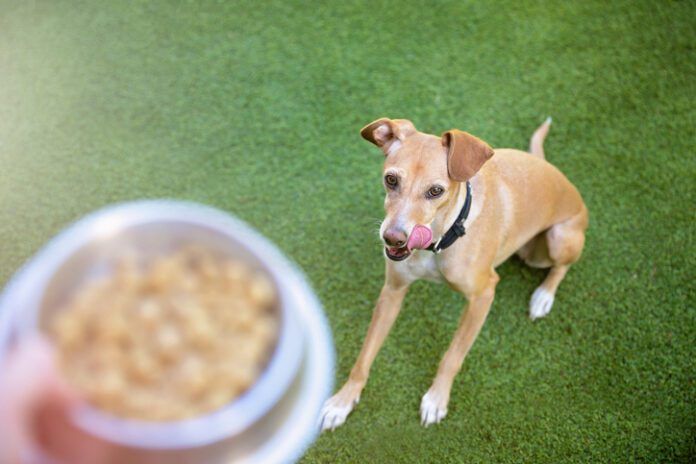A study that made headlines in 2022 found an association between dogs who were fed just once a day and a lower likelihood of having a variety of health problems. However, one of the study’s authors, Matt Kaeberlein, Ph.D., Professor, Department of Laboratory Medicine and Pathology and the University of Washington School of Medicine, says this correlation should not spur owners to change their dogs’ feeding schedules.
The study was conducted by researchers at the Dog Aging Project, which since 2019 has collected data on thousands of companion dogs of different ages, sizes, and breeds in an effort to understand how genes, lifestyle, and environment influence aging. Studies of intermittent fasting and time-restricted feeding in laboratory rodents have shown beneficial health outcomes. The Dog Aging Project’s researchers wanted to investigate whether there were associations between feeding frequency and a number of broad categories of health conditions (such as cognitive dysfunction, gastrointestinal, dental, orthopedic, kidney/urinary, and liver/pancreas disorders) in dogs.
In each of these categories, dogs fed only once daily were less likely to be diagnosed with health problems than dogs who were fed twice or more often per day – but, Kaeberlein says, “It’s important to recognize that correlation does not equal causation, and there are many possible explanations for this observation, which is why more detailed studies are required. For example, dogs fed once a day may be less likely to be obese, and we know that obesity is associated with a variety of health risks in both dogs and humans. So my advice would not be to change the frequency at which people feed their dogs based on our study, but instead focus on making sure that your dog is getting a nutritious diet and maintaining a healthy weight.”
How Many Times a Day Should a Dog Eat?
Puppies are generally weaned around the age of 6 to 8 weeks, and should be given three or even four meals a day, in order to prevent hypoglycemia (low blood sugar). As pups mature, they become increasingly able to maintain stable blood sugar levels for longer periods of time, and by the age of six months, their meal frequency can be reduced to two a day. By the time they are fully grown, dogs are perfectly able to subsist on just one meal a day, but this is largely a matter of owner preference. Some owners impose a one-meal-a-day feeding regimen on their dogs while others feed two or three times a day. There is no single feeding schedule that guarantees health and longevity. However, the total amount that is fed to a dog each day will critically impact his health. Overfeeding any dog leads to obesity, and obesity practically guarantees health problems.
Discuss the amount of calories your dog or puppy should be eating with your veterinarian to determine how much food to feed your dog daily. Once you know how many calories he should eat in the form of a complete and balanced diet, you can divide that number of calories by any number of mealtimes you’d like to feed, whether that’s one, two, three, or even more. As long as the amount of calories he consumes in a day doesn’t increase out of proportion with his age and ideal weight, the number of mealtimes won’t matter.
Professor Kaeberlein, who is one of the founders of the Dog Aging Project as well as a co-author of the study on the frequency of meals, has one dog, an elderly German Shepherd named Dobby. Dr. Kaeberlein says he feeds Dobby three meals a day and his weight and overall health are good.







LOL! There is no way that my four times a day eater would tolerate going down to only once a day. But I monitor her calorie intake closely and she is lean and fit.
My now deceased canine soulmate was part of that study as she was a participant in the Dog Aging Project.
When the study results first made headlines last year, I was astounded at the reaction by some of the so-called “experts” online. One pair in particular came across as trying to intimidate people into changing their dogs’ feeding schedule “right now or risk causing their premature death”. That attempt at intimidation stirred up my irritation to the point where I no longer have any respect for either of them.
My girl was on a two meals/day schedule because that’s what worked best for her. My current pups – 15-month-old male and 9-month-old female Golden Retrievers – are on a 3 meals/day schedule because that’s what works best for them. I feed them a slightly varying amount of food based on how much physical exercise they get each day. That way I can keep them fit and healthy.
I dare say that the study can hardly be considered “controlled” since the data collected was not just from the individual veterinarians treating the dogs; but also from the dogs’ guardians who may or may not have submitted accurate data to begin with based on their own ability to recall specific information requested. I know I struggled to recall actual data related to my girl – mainly because at some points during the study we had an additional dog, plus I was my hubby’s primary caregiver (he was a dementia patient).
I have a dog who would get too much acid built up in his stomach if I only fed once a day. I wonder how this problem was considered in the study.
And what about giant breeds that are in risk of bloat? I feed my danes twice a day because of that. I wonder if that was considered by the investigators.
My vet suggested I feed our large dog twice a day to guard against bloat. I followed her instructions and though all her litter mates died at 8 or 9 years she lived to be almost 12 years. I fed her once in the a.m.and again in the p.m..